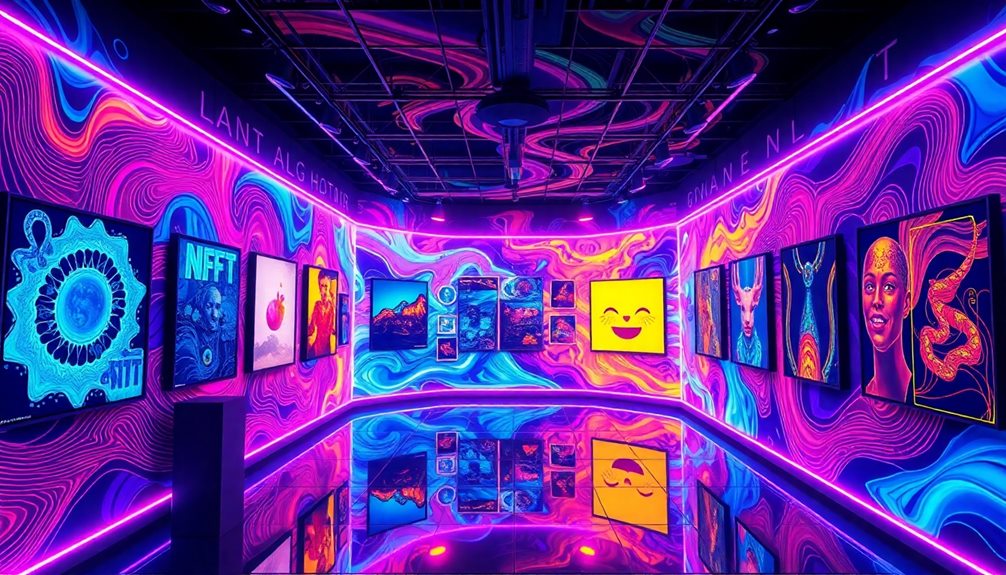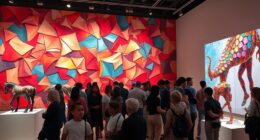Understanding video art means recognizing its unique blend of moving images and sound. It emerged in the 1960s, thanks to advances in affordable video technology that made it accessible for artists. Video art challenges traditional narratives by offering non-linear storytelling and engaging viewers on multiple levels. Artists like Nam June Paik and Andy Warhol helped shape the genre, using it to explore cultural critiques and personal identity. Today, video art not only captures moments but also prompts reflection on social issues. There's a lot more to uncover about its themes and impact, so keep exploring to deepen your understanding.
Key Takeaways
- Video art combines moving images and sound to create immersive experiences, emerging in the 1960s with advancements in technology.
- Non-linear narratives and spatial manipulation are essential techniques that encourage personal interpretation and emotional engagement.
- Influential artists like Nam June Paik and Bill Viola have significantly shaped video art's direction and themes, such as identity and spirituality.
- Video installations often integrate live performance, enhancing the relationship between viewer and artwork while challenging societal norms.
- The accessibility of video art fosters broader audience connections and promotes critical discussions on cultural shifts and social justice.
Definition and Fundamentals

Video art captivates audiences by harnessing the dynamic qualities of moving images and sound as its primary means of artistic expression. As a new medium that emerged in the 1960s, video art shifted the landscape of contemporary art, allowing artists to explore innovative ways to convey their messages.
With the advent of affordable video technology, creating art became accessible to a broader range of artists.
Video installations, one of the most popular forms of video art, combine multimedia integration with spatial elements, immersing viewers in a rich sensory experience. You'll notice that artists who use this medium often manipulate time, creating fluid narratives that challenge traditional storytelling.
The key characteristics of video art—time manipulation, spatial distortion, and flexible narrative structures—invite you to engage with the work on a deeper level.
In this domain, experimental film techniques are often employed, pushing the boundaries of artistic expression. The integration of sound, movement, and visual elements creates a unique dialogue that captivates and provokes thought, encouraging you to reconsider what art can be.
Embracing these fundamentals, video art continues to evolve and inspire.
Historical Evolution

Historically, video art has often evolved in response to technological advancements and cultural shifts. Video art was born in the late 1960s, primarily due to the rise of consumer video technology and vibrant cultural movements in the US and UK. Nam June Paik, often hailed as the father of video art, showcased innovative works at the Parnassus gallery in 1963, marking a pivotal moment in the historical evolution of this artistic medium.
Throughout the 1970s, developments in video art flourished as artists like Joan Jonas and Peter Campus pushed the boundaries of video formats and narrative structures. Their experiments laid the groundwork for more complex video installations that began to emerge.
By the 1980s and 1990s, advancements in digital technology and decreasing editing software costs opened up new possibilities, allowing a fresh generation of creators to explore video art with unprecedented freedom.
Notable festivals, such as the World Wide Video Festival and Ars Electronica, played essential roles in promoting video art and underlining its significance within contemporary culture. Through these cultural movements, video art has continued to grow and adapt, reflecting the ever-changing landscape of artistic expression.
Key Themes and Techniques

Artistic expression in video has been shaped by key themes and techniques that distinguish it from traditional forms. Video art often employs non-linear narratives, allowing you to engage emotionally and interpret meaning in your own unique way. This approach challenges conventional storytelling, making it a powerful medium for exploring complex themes like identity and societal norms.
Techniques such as spatial perception and the integration of performance art are significant in video art. Artists like Joan Jonas and Andy Warhol push boundaries, prompting you to rethink how narratives unfold.
Early video art also drew heavily from television, with figures like Wolf Vostell using parody and satire to critique the medium's influence on society.
The technological advancements of the 1980s, including color TV and special effects, further expanded what video artists could achieve. These innovations opened up new avenues for experimentation, blending imagery and sound in ways that invite critical discussion.
Ultimately, video art serves as a platform for tackling personal and taboo subjects, enabling you to engage with discussions about media and identity in a public forum.
Influential Artists and Works

Influential artists and their groundbreaking works frequently push the boundaries of video art, shaping its evolution and expanding its possibilities. Nam June Paik, often called the father of video art, created pivotal works like "TV Cello," which integrated television into art, showcasing the medium's potential for expression.
Other artists have also made significant contributions. For instance, Andy Warhol's minimalist "Sleep" influences contemporary creators with its extended duration, while Martha Rosler's "Semiotics of the Kitchen" critiques traditional homemaker stereotypes, challenging societal norms. Bill Viola's "The Reflecting Pool" explores themes of emergence and spirituality, revealing the emotive power video can hold for introspection. Joan Jonas's "Vertical Roll" creatively intertwines live performance with video, exploring identity and societal reflections through innovative techniques.
| Artist | Notable Work |
|---|---|
| Nam June Paik | TV Cello |
| Martha Rosler | Semiotics of the Kitchen |
| Bill Viola | The Reflecting Pool |
These artists and their works highlight the diverse capabilities of video as a medium, transforming it into a compelling form of artistic expression.
Cultural Impact and Reception

Through its innovative lens, video art challenges societal norms and provokes critical thinking about contemporary issues. This medium has become an essential part of the art world, reflecting and critiquing cultural shifts while amplifying activism and social justice. As you engage with video art, you'll notice how it addresses pressing societal themes, fostering public discourse around topics that are often overlooked.
The accessibility of video art enables a broader audience to connect with diverse voices and narratives, enriching the cultural conversation. Artists leverage this medium to explore personal and taboo subjects, reflecting a growing acceptance of varied perspectives in contemporary culture.
The integration of new technologies has transformed the thematic exploration within video art, allowing for innovative storytelling methods that resonate deeply with viewers. In major exhibitions and institutions, you can witness the powerful impact of video art as it documents social movements and inspires change.
Frequently Asked Questions
What Is the Concept of Video Art?
Video art's concept revolves around using moving images to convey ideas and emotions. You'll find it challenges traditional art forms, encouraging you to engage actively with the experience while exploring innovative narratives and visual techniques.
What Is the Art of Taking Videos Called?
Did you know that video consumption has increased by over 100% in the past decade? The art of taking videos is known as "video art," where artists creatively express ideas through moving images and innovative techniques.
How Do You Read and Understand Visual Art?
To read and understand visual art, you need to contemplate its context, analyze its formal elements, engage with its themes, and reflect on your personal interpretation. This approach deepens your connection with the artwork's meaning.
How Is Video Art Different From the Art of Filmmaking?
Think of video art as the wild child of visual media. Unlike filmmaking's structured storytelling, video art embraces spontaneity, non-linear narratives, and interactive elements, inviting you to interpret and engage with it on your own terms.
Conclusion
In exploring video art, you'll find it's more than just moving images; it's a powerful medium that challenges perceptions and blurs boundaries. From its historical roots to contemporary expressions, video art invites you to engage with diverse themes and techniques. As you reflect on the influential artists and their groundbreaking works, you might ask yourself: how does video art reshape your understanding of creativity and culture today? Embrace the journey, and let the visuals speak to you.









